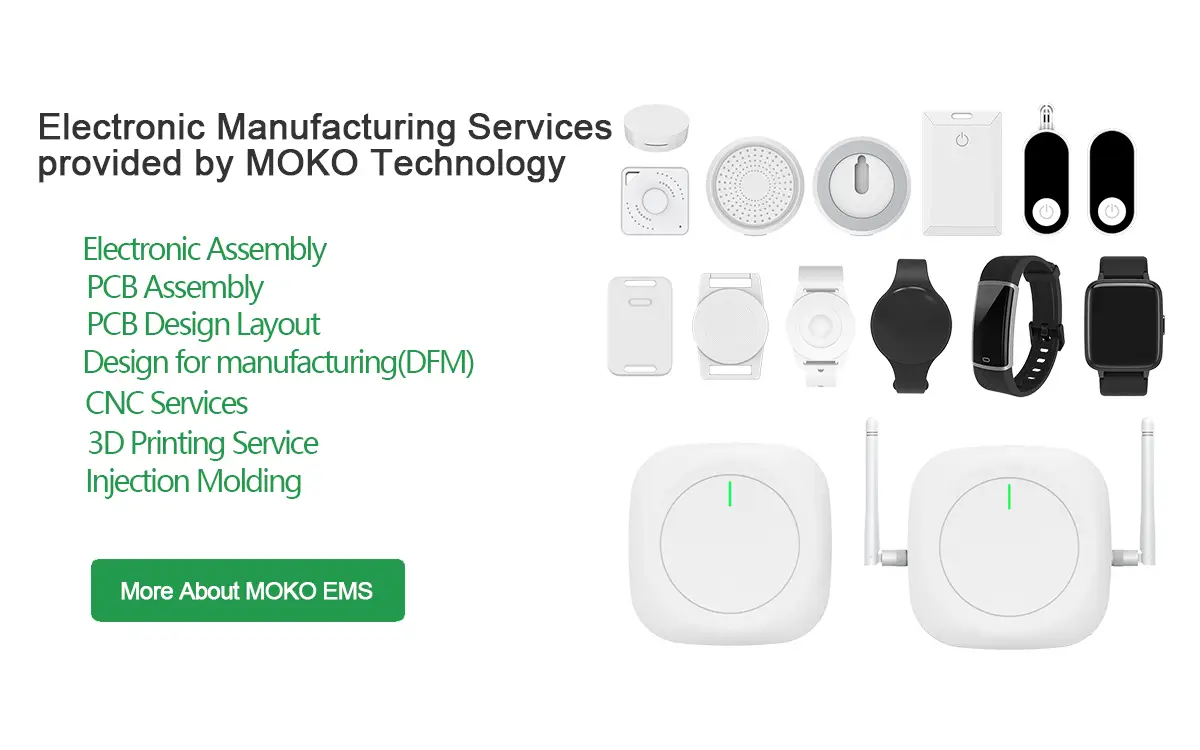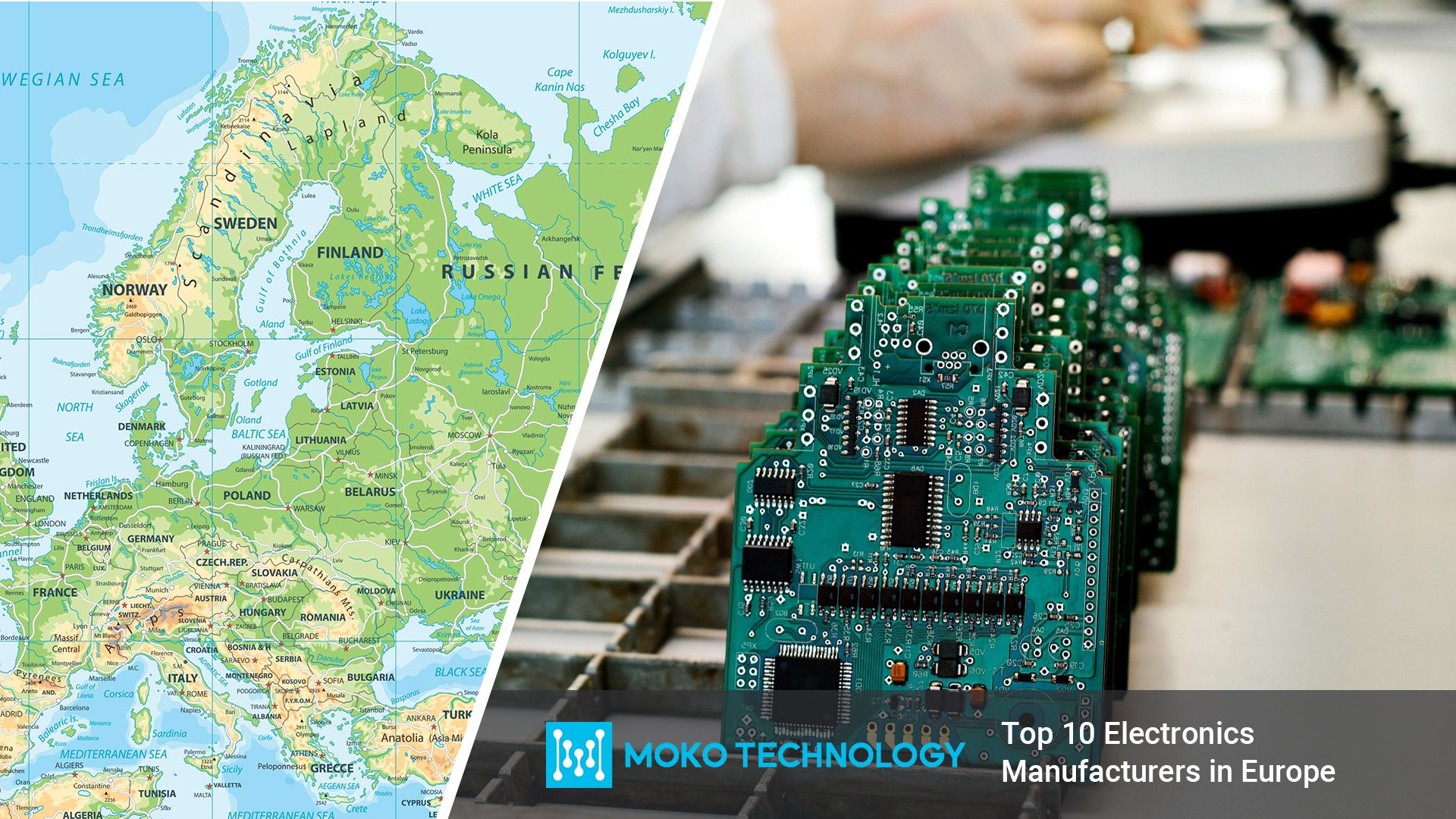According to reports, the global electronic manufacturing services (EMS) market will increase to USD 797.94 billion by 2029, growing at a CAGR of 6.8% over the forecast period. The whole market grows rapidly which is driven by industries like telecommunication and medical, and according to the statistics, most end-users of EMS are from communication and computer hardware industries account for about 59% of the total demand.
The demand for electronic manufacturing services is constantly increasing, more and more companies start to outsource such services to reduce the cost caused by large inventory, warehouse construction, and maintenance, so they can shift the investment into other aspects such as sales, marketing, research, and development. With the rising demand, competition among electronic manufacturing service providers has also intensified, but this has also raised global norms in the EMS industry. The EMS companies are devoted to upgrading their facilities and applying new technologies such as virtual reality, the Internet of Things (IoT), and 3D printing to improve their production efficiency and quality. And they build collaboration with many Original Design Manufacturers and Original Equipment Manufacturers to enhance their EMS performance.
Electronic Manufacturing Services Market Analysis
1. EMS Market Share in Different Regions
Based on geographic location, the entire EMS market can be divided into five regions, which are North America, Europe, Asia Pacific, the Middle East & Africa, and South America.
1.1 Asia Pacific Region
Asia Pacific is the largest electronic manufacturing services market that was valued at more than USD300 billion, which would keep expanding in the future. And countries like China, Vietnam, Japan, Korea, and Singapore play important role in this area’s EMS market, especially China. It is one of the most important EMS markets players in the world that fabricates and assembles about 60-70% of the world’s electronics, which also plays an important role in consumer electronics, semiconductors, and other telecommunication products.
![]()
In addition, the Chinese EMS market is expected to grow further thanks to its world-leading 5G technologies. More than 50 cities are covering 5G services in China, which can definitely raise the demand for telecommunication and navigation devices to drive the growth of electronic manufacturing services.
1.2 Europe EMS Market
The European electronics manufacturing services market is undergoing huge changes, the product design, development, and manufacturing processes begin to separate. And the emerging economies in Europe like Romania, Bulgaria, Slovakia, Estonia, Belarus, and Turkey attract more and more manufacturers’ attention.
This market is expected to reach USD 110 billion by 2026 with a CAGR of over 5%, and the Eastern European EMS market accounts for about 50% of the total European EMS markets. Thanks to the European Union which supports fabricating electric vehicles, electronic lighting, and safety electronics, the EMS market in the region is growing strongly. In addition, there are many automotive manufacturers in Europe such as BMW and Ford that work with EMS providers for PCB manufacturing and assembly, designing, engineering, prototyping, and so on.
1.3 North and Latin American EMS Market
The North American market grows strongly in 2022, and the total electronic manufacturing services market in the United States and Canada exceeds 90 billion US dollars, which is driven by rapid urbanization and steady population growth. Along with the emergence of new technologies, the demand for electronics manufacturing services grows significantly, especially in young generations who are interested in using kinds of consumer electronics. In addition, North America is investing heavily in R&D activities, including the development of high-end automobiles and spacecraft, increasing the demand for EMS across the region.
The Latin American electronics manufacturing services market reaches approximately US$60 billion in 2022, with the economies of Brazil, Mexico, and Argentina accounting for more than 80% of the total EMS market in the region that will continue to lead the growth of electronics manufacturing in Latin America in the future.
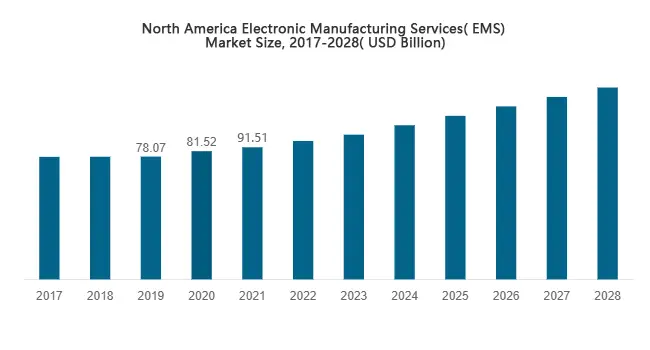
1.4 The Middle East & Africa EMS Market
In 2022, the EMS market size in the Middle East and Africa has expanded thanks to the substantial R&D activity, adoption of electric vehicles, and the increasing demand for consumer and automotive electronics. Meanwhile, a variety of industries start to utilize new technologies like IoT and 3D printing that also helps to boost the growth of the electronics manufacturing services market in this area. In the future, more and more investors will enter the Middle East and Africa EMS market where the labor costs are much lower.
2. EMS Market Size by Industries
Classified by industry, the EMS market can be segregated into automotive, communications, computer, consumer electronics, industrial, healthcare, and so on.
As shown in the figure below, the top three industries that used the most electronic manufacturing services are the communications, computer, and consumer electronics industries respectively. And the communications industry ranks NO.1 accounting for 30.1%. The main reason is the wide application of networking and wearable technologies that drives the growth of the communications electronic market. On the other hand, the digitization of the market requires the use of complex electronic devices and functions, as well as a high level of networking, which makes electronic manufacturing services more widely used in the communications industry.
Among these industries, the healthcare segment has the greatest growth potential with the highest CAGR, the digital health market is projected to grow in value at over $90 billion by 2025. The medical devices tend to be designed and fabricated in a smaller size but with more functions, thus, the electronics should also comply with these trends. In fact, many advancements in the healthcare industry have benefited from sophisticated electronics, for example, medical devices such as X-ray equipment and pacemakers equipped with high-quality electronics are capable of offering patients better ways to diagnose and treat.
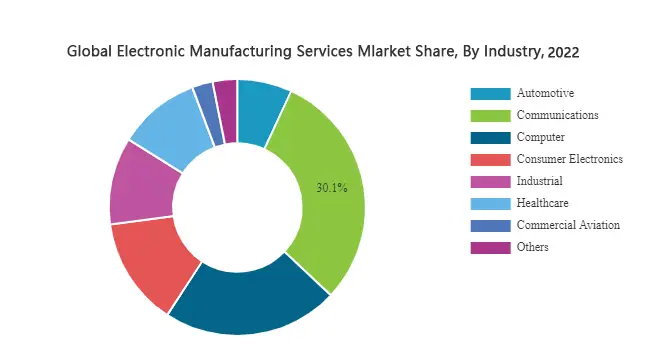
FIND OUT HOW TO SELECT THE RIGHT EMS FOR YOUR PROJECT
3. EMS Market Analysis by Various Services
According to different services, the electronic manufacturing services market can be segmented into electronics manufacturing services, engineering services, electronics assembly, testing, supply chain management, and others.
Among these segments, electronics manufacturing is leading the global market because of the popularity of smart home products in developing countries, especially in China, which helped the dramatic growth in the electronic manufacturing segment in the past few years. In order to meet the ever-increasing demands of people on electronic products, electronics manufacturers are devoted to developing electronic products with more functions by integrating several new technologies such as artificial intelligence, big data processing, 3D printing. They are constantly improving their manufacturing performances to develop more new products so as to meet people’s high requirements of the electronic devices.
For the electronics assembly segment, it is expected to witness strong growth at the fastest CAGR. Almost every industry requires the electronics assembly service, and the top 5 industries that require to use such service most are automotive, communications, computers, consumer electronics, and industrial. There is a trend that many companies prefer to outsource the assembly services as it can lower facility and equipment costs, and labor costs as well. On the other hand, outsourcing assembly service allows these companies to pay more attention to other aspects of their business such as R&D and marketing.
The Impact of COVID-19 on the EMS Market
The COVID-19 impacts every country in the world and has a considerable impact on the electronic manufacturing services market. As Organization for Economic Co-operation and Development(OECD) reported: 43% of global electronics manufacturers and suppliers are negatively affected due to the COVID-19.
Many factories are forced to close or reduce staffing levels, and manufacturers have to streamline their product lines, which causes severe effects on the global electronics supply chains. In addition, it has created problems with insufficient supply of raw materials as well as rising prices, there are fewer flight available because of the local policies on epidemic control, which makes the supply time of raw materials longer and makes the shipping charge even more expensive. In 2022, the problem of chip shortages continues to affect the automotive industry, many automakers have to halt production which causes huge economic losses.
Thus, more and more companies started to rethink their business strategy and shift electronics manufacturing and assembly services to areas where COVID-19 is under control. While compared to other countries in Asia, China had excellent performance in epidemic control, it would be a good choice to outsource your EMS in this country.
It is not yet clear how the situation of the epidemic will develop in the future, but we need to plan ahead. As a leading electronics manufacturer in China, MOKO has extensive experience and has already taken measures to deal with the epidemic by increasing warehouse capacity, maintaining regular meetings with suppliers to reduce any risks. With specialized knowledge, MOKO understands the market well and provides customers with the best EMS service within their budget.
Electronic Manufacturing Services Market Development Trends and Challenges
1. New Trends in EMS Market
There are several trends that will bring new shifts to the EMS industry, and these shifts will impact the way the business operates and how electronics manufacturing operates, and take the whole EMS market to a new level. Below are listed the main trends in the electronic manufacturing services industry, helping you understand how these trends will dominate in shaping and guiding the development of the electronics industry.
1.1 Wearable Technologies
The global wearable technology market size is projected to reach USD118.16 billion in 2028 at a compound annual growth rate of 13.8%. A report from GlobalWebIndex claims that 64% of Internet users have already used or are interested in using wearable devices, and about 71% of those aged 16 to 24 are interested in this technology. Thus, we can see that there is huge potential for market development in this area, which would definitely affect the EMS market layout.
Wearable technology brings much convenience to our life, which allows us to monitor our fitness levels, track location and free our hands. It also plays an important role in the medical and healthcare industries. The wearable devices are equipped with sensors, flexible electronics, and wireless technologies that can monitor the health status of patients, building a real-time communication bridge between at-home care and medical professionals.
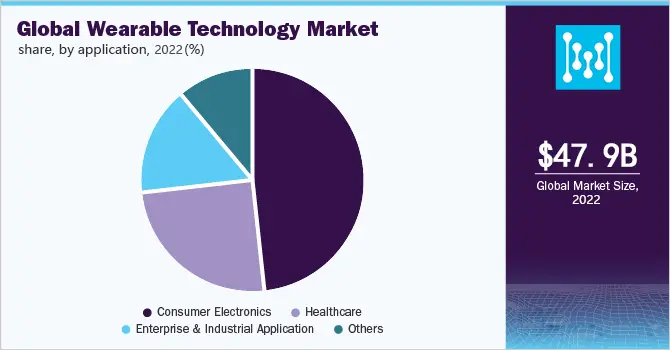
1.2 3D Printing
A research from Globenewswire mentioned that the global 3D printing market size is projected to grow from USD 18.33 billion in 2022 to USD 83.90 billion by 2029, exhibiting a CAGR of 24.3% during the forecast period. The growing demand for prototyping in healthcare, automotive, aerospace, and defense industries is expected to drive the growth in the 3D printing market. This technology is much popular in Western Europe and North America, in fact, US and Canada adopted the 3D printing technologies first in various manufacturing processes, and North America accounted for more than 35% share of the global market in 2022. And the Asia Pacific is projected to witness the highest compound annual growth rate during the forecast period, as the development and upgrading of the manufacturing industry in the Asia-Pacific region promote the widespread adoption of additive manufacturing in the region. As a stronghold for consumer electronics manufacturing, the region is also developing as a manufacturing hub for the automotive and healthcare industries, favoring the growing demand for 3D printing in the region.
1.3 IoT Technology
IoT is no longer a strange technology, which is applied in a variety of applications and industries including smart cities, healthcare, transportation, agriculture, etc. And many tech domains have a close association with it such as cloud computing, artificial intelligence, and machine learning. The emergence of IoT technology brings a new level of convenience and improves our lives in many aspects. For example, the medical device industry has been utilizing IoT technology for many years for data cloud computing, signal processing, and data analysis, which helps to achieve telemedicine that allows doctors to diagnose and treat patients at a distance. As reported, the global internet of things market is expected to reach $478.36 billion in 2022 and reach a market cap of $2,465.26 billion in 2029.

1.4 Shifting from B2B To B2B2C
In the past, many electronics manufacturers prefer a business-to-business(B2B) operating mode. But in recent years, another mode has emerged that is business-to-business-to-consumer (B2B2C), which allows electronics manufacturers to sell products to clients directly. Obviously, there are many benefits of this new model. First, it provides access that allows manufacturers to get more information about customers, which is not possible in B2B operating mode. With this information, they can offer custom-tailored products to clients and improve customer satisfaction. Second, it can reduce costs. B2B2C can reduce the cost caused by intermediaries, and B2B2C partners can share across multiple businesses to decrease the cost as well. On the other hand, by partnering with others, manufacturers have more opportunities to enter into new markets to expand their business. Last, manufacturers can control their branding and pricing by using B2B2C model. In the B2B model, there is less control about their brands as they don’t contact the customer directly, and customers have no idea about who they are buying from, but B2B2C can solve such a problem. Manufactures can reach end customers and show more information about their brands.
1.5 Virtual Reality (VR) and Augmented Reality (AR)
Virtual reality (VR) and augmented reality (AR) are new emerging technologies that have been applied in more and more applications such as medical training, navigation, entertainment, and are also very popular in product design and development. These technologies can be integrated with computer-aided design, which helps designers to make more precise and timely revises before manufacturing that avoids huge economic loss during the production phase caused by unreasonable designs. In addition, the use of VR and AR technologies can shorten the inspection time and eliminate errors as workers can identify errors better and faster.
1.6 Big Data
In the past, big data was generally only used by large companies because the economic cost for small and medium-sized enterprises was very high. But with the advent of the Internet of Things and other cutting-edge technologies, large and small companies can all access information from multiple sources, allowing big data to maximize its value. With the information provided by big data, electronics manufacturers can better arrange production, adjust strategies to reduce production costs, improve profits and production efficiency, and ultimately increase market share. For example, with big data, manufacturers can pinpoint their target customer groups and understand their preferences and needs to develop products that customers really want. At the same time, big data can also help electronics manufacturers overcome various problems by anticipating the challenges they may meet in the future.
1.7 Use of Industrial Robotics
Over the years, industrial robots have been mainly used in the automotive industry, but in recent years they have been more widely used, especially in the electronics manufacturing industry, where industrial robots play an important role in almost every phase of production. They can complete assembly and dispensing, machining and cutting, material handling and picking, etc. Unlike a human, robots can work 24 hours a day without breaking only if there is no failure, which can greatly improve work efficiency. On the other hand, industrial robots can finish work with high accuracy and repeatability, which avoids the possibility of errors and rework. The use of robots in electronics manufacturing enables miniaturization, which also leads to a substantial increase in the use of industrial robots, with global sales increasing by about 16% and expected to continue to grow in the future. In a word, industrial robots are essential tools in electronics manufacturing that would drive the development of the EMS industry as well.
1.8 Use of ERP Systems
ERP(enterprise resource planning) system is a great method if electronic manufacturers want to expand their business. There are many benefits to using ERP systems. First, it is a platform that allows manufacturers to optimize and automate information quickly and in real-time. With real-time information, they can make quick responses and make adjustment about their business strategy to meet customers’ needs better. Second, the use of ERP systems can improve work efficiency and productivity, as ERP systems can simplify processes and collect all data in one place, making a more efficient and data-driven work environment. Third, ERP systems can lower costs as it allows manufacturers to expand the business without additional staff.
ERP systems have been used for several years, but with the development of the electronic industry and technical advancements, they are expected to be developed more reliable and valuable in electronic manufacturing services.
1.9 Leveraging the Supply Chain
There are many ways available to improve companies’ market competitiveness, and one of the most efficient ways is supply chain management, which helps to make more profits and offers a more efficient business operation mode. For example, new emerging technologies in logistics can speed up shipping time and shorten the turnaround time to improve the whole supply chain. It also provides more flexibility for electronic manufacturers, making them more adaptable to changing market demands. In a similar way, manufacturers can make improvements in operations planning, inventory control, material purchase, and so on, and ultimately increase their market share in the electronic manufacturing services market.
2. Challenges in EMS Market
Even though the EMS market has great prospects in the future, it also faces some issues and challenges.
2.1 Shrinking Operating Margins
With increasing global competition and the use of advanced technology, the price of electronic products has been driven down. On the other hand, OEMs are demanding constant cost reductions, which has negatively impacted EMS providers’ profit margins in certain lines of business. Therefore, if manufacturers want to stay profitable, they must take some measures to improve production efficiency, such as introducing cutting-edge technology, upgrading equipment, and streamlining production processes, etc.
2.2 Complex Global Supply-Chain
While complying with the international standards, EMS companies must balance internal and external resources. Additionally, traceability and compliance issues add to the operational burden, with components and sub-assemblies likely to travel across several continents before reaching end consumers.
2.3 Supplier Quality Management
Leveraging the global supply chain management is a trend among electronics manufacturers now, thus, working with the right supplier is the key to success. Manufacturers must have a good understanding of suppliers to make sure that they are professional and reliable. It would be better to build a quality and traceability system that allows them to control the quality and get good post-production service.
2.4 Short Product Lifecycles
The rapidly changing consumer preferences for electronic products result in short product life cycles. To gain more customers and take market share, electronics manufacturers must be flexible and responsive. Formulate effective NPI processes, and maintain information sharing and communication among various departments, so as to manufacture products that meet customer needs as quickly as possible.
2.5 Market Uncertainty
The electronics manufacturing market is subject to economic fluctuations and cyclical consumer demand, and the uncertainty of the entire market is a big challenge for manufacturers. For example, the mascot of the 2022 Beijing Winter Olympics “Bing Dwen Dwen” is much popular in the world that leads to a surge in orders, but it is still in short supply. In the face of this situation, manufacturers need to speed up production to keep inventory in line with demand, which works also in the electronics manufacturing industry.
2.6 New Regulations and Standards
Manufacturers must comply with new regulations and standards, and make adjustments based on them. For example, the new regulation requires electronic manufacturers to take on more social responsibility and produce more sustainable electronic products. Therefore, manufacturers must take the product life cycle into consideration when designing and developing electronic products.
Top 10 Electronic Manufacturing Services Providers
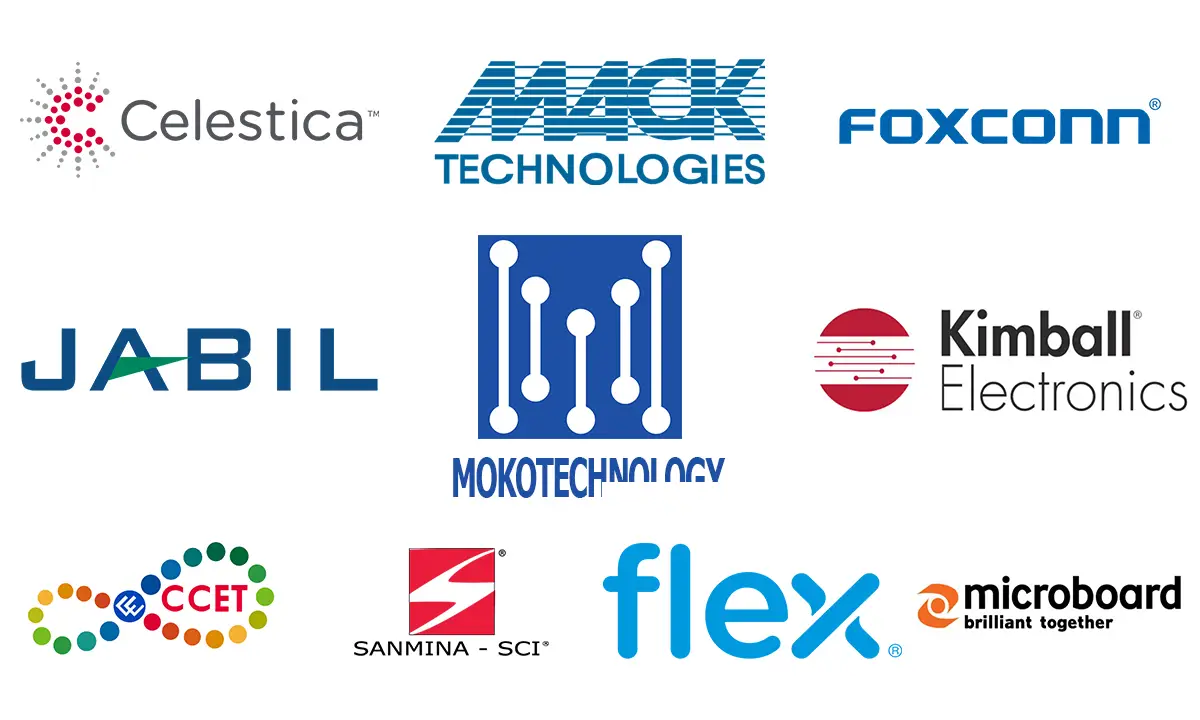
1. Celestica
With more than 70 years of experience in electronic manufacturing services, Celestica specializes in providing high-reliability design, manufacturing, and supply chain solutions, helping customers from the drawing board to after-market services and everything in between. It has offices in North America, Asia, and Europe, and has built a comprehensive global network that can serve global customers faster and more efficiently.
2. Mack Technologies
Mack Technologies is a leading electronic manufacturing service provider, which belongs to Mack Group that is a full-service contract manufacturer founded in 1920. The headquarter is located in Westford, MA, and it operates three manufacturing facilities in North America with 337,000 square feet of manufacturing space. Mack Technologies has served clients in a wide array of industries including defense, aerospace, medical device, and industrial products.
3. Foxconn
Foxconn is the largest electronics manufacturing services provider and also the fourth-largest technology company by revenue in the world, it manufactures electronic products for many famous companies such as the BlackBerry, iPad, iPhone, Nokia, Sony devices, and so on, and about 40% of all consumer electronics are manufactured by Foxconn. It has many factories around the world, of which China has the most factories, with a total of 12 factories.
4. Jabil
Established in 1966, Jabil has extensive experience in design, manufacturing, and supply chain management. With more than 260,000 employees across 100 locations in 30 countries, it is a global electronic manufacturing company covering 500+ million square feet of manufacturing space. Jabil provides electronic products for many industries ranging from healthcare, consumer electronics to automotive.
5. MOKO Technology
MOKO Technology is a global leading expert in Electronic Manufacturing Services, providing end-to-end EMS services to customers around the world. Established in 2006, it has 16 years of experience in electronic manufacturing. There are about 400 employees at MOKO, covering an area of about 13,000 square meters. MOKO offers full-scale services ranging from New Product Introduction, engineering to PCB manufacturing and assembly services, and they are capable of handling prototypes, low to high volume production runs, and everything in between.
6. New Kinpo Group
Founded in 1973, New Kinpo Group has become the world’s leading electronics manufacturer. The group owns four listed companies: Kinpo Electronics, Cal-Comp Electronics, AcBel Polytech and CastleNet. It mainly provides electronic manufacturing services, original design and manufacturing services, and independent brand product development for global customers. Their private label products include 3D printers, smart beauty products and artificial intelligence robots.
7. Plexus
With more than 19,000 team members around the world, Plexus has advanced support and supply chain capabilities that allow the company to source materials faster, respond faster. It integrates engineering, manufacturing, service, and supply chain to streamline processes and improve work efficiency.
8. Sanmina
Founded in 1980 in Silicon Valley, Sanmina owns about 35,000 employees in the world. It specializes in designing, manufacturing, and repairing complex optical, electronic, and mechanical products. Sanmina provides a full-scale of services such as design, manufacturing, and logistics solutions for customers from 20 countries in various sectors like industrial, medical, defense and aerospace, automotive, communications networks, and so on.
9. Flex Ltd
Founded in 1969, Flex Ltd., formerly known as Flextronics, Inc., is a multinational and diversified electronics manufacturing company. It mainly provides EMS and ODM services, the corporate headquarters are in Singapore and the administrative headquarters are in San Jose, California. Currently, the company has 160,000 employees in more than 30 countries around the world.
10. Microboard Processing
Founded in 1983, Microboard Processing has accumulated about 40 years of experience in electronic manufacturing. The founder Craig Hoekenga, before entering the EMS industry, is one of the most famous efficiency consultants in the United States. And now Microboard has become a leading electronics manufacturer, with engineers across multiple disciplines and a powerful software suite and process controls to serve a variety of sectors like the defense, medical, telecom, and industrial.
Conclusion
The continuous improvement of consumers’ requirements for electronic products promotes the rapid development of the EMS industry. If they want to better serve customers and increase their market share, then electronic manufacturers must respond flexibly and be able to keep up with the rhythm of rapid changes.
MOKO closely follows the pace of the times, innovation is the force that drives MOKO to make improvement constantly. We use world-leading equipment and advanced technology, and continuously streamline our production process, aiming to provide customers with the best electronic products. We would work with you closely through your entire product development life cycle from the concept design, engineering to manufacturing to improve your market competitiveness.

